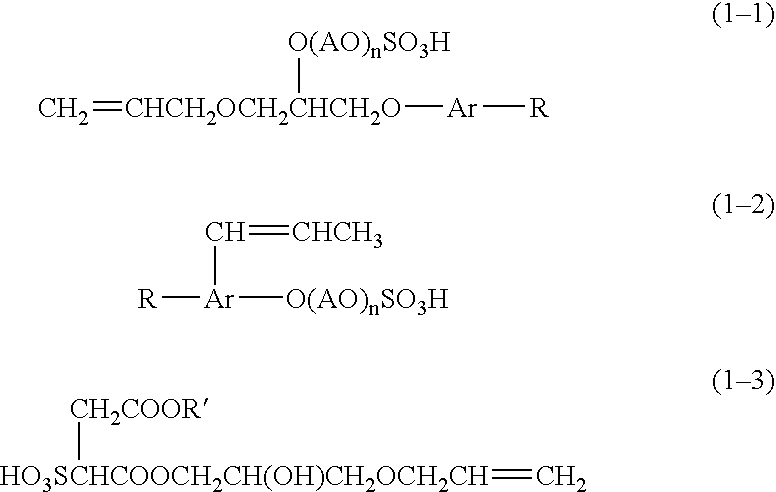Composite resin particle with specific shape factor
a technology of specific shape factor and composite resin, which is applied in the field of composite resin particles, can solve the problems of paint peeling easily, poor adhesiveness to a substrate, and reduced affinity of resin particles obtained by solubilized resin suspension methods
- Summary
- Abstract
- Description
- Claims
- Application Information
AI Technical Summary
Benefits of technology
Problems solved by technology
Method used
Image
Examples
production example 1
[0400]A reaction vessel fitted with a stirrer and a thermometer was charged with 47 parts of styrenated phenol EO adduct (Eleminol HB-12, SANYO KASEI KOGYO) and 232 parts of bisphenol A diglycidyl ether (Epikote 828, YUKA SHELL), which were dissolved uniformly.
[0401]Then, water was added dropwise to the reaction vessel with stirring. Upon adding 31 parts of water, the inside of the reaction vessel was emulsified and became milky white. After a further dropwise addition of 224 parts of water, an emulsion (1) was obtained.
[0402]This emulsion (1) was heated to 70° C., and treated dropwise with a mixture of 20 parts of ethylene diamine and 446 parts of water over a period of 2 hours while keeping the temperature at 70° C.
[0403]After completion of the dropwise addition, the reaction and the maturing were ensured at 70° C. for 5 hours followed by 90° C. for 5 hours, whereby obtaining an amine-cured epoxy resin aqueous dispersion [resin microparticle (A1) dispersion].
[0404]The [resin micro...
production example 2
[0406]A reaction vessel fitted with a stirrer and a thermometer was charged with 683 parts of water, 11 parts of methacrylic acid EO adduct sulfate sodium salt (Eleminol RS-30, SANYO KASEI KOGYO), 139 parts of styrene, 138 parts of methacrylic acid and 1 part of ammonium persulfate, which were stirred at 400 rpm for 15 minutes to obtain a white emulsion.
[0407]This emulsion was heated to 75° C. and reacted for 5 hours. Then 30 parts of a 1% aqueous solution of ammonium persulfate was added, and the mixture was matured at 75° C. for 5 hours to obtain an aqueous dispersion [resin microparticle (A2) dispersion] of a vinyl resin (styrene-methacrylic acid-methacrylic acid EO adduct sulfate sodium salt copolymer).
[0408]The [resin microparticle (A2) dispersion] was observed by an LA-920, which revealed the volume average particle diameter of (A2) was 0.12 μm.
[0409]A part of the [resin microparticle (A2) dispersion] was dried to isolate a resin portion {resin microparticle (A2)}. The Tg of (...
production example 3
[0410]A reaction vessel fitted with a condenser, stirrer and nitrogen inlet was charged with 343 parts of bisphenol A EO 2-mole adduct, 166 parts of isophthalic acid and 2 parts of dibutyltin oxide, and the reaction was conducted under atmospheric pressure at 230° C. for 8 hours, followed by the reaction for 5 hours under reduced pressure of 10 to 15 mmHg, and then the mixture was cooled to 110° C., combined with 17 parts of isophorone diisocyanate in toluene, reacted for 5 hours at 110° C., made free of solvent, whereby obtaining an [urethane-modified polyester (1)] whose Mw was 72,000 and whose isocyanate content was 0.7%.
[0411]On the other hand, 570 parts of bisphenol A EO 2-mole adduct and 217 parts of terephthalic acid were subjected to a polycondensation at 230° C. for 6 hours similarly as described above to obtain a non-modified [polyester (2)] whose Mn was 2,400, whose hydroxyl value was 51 and whose acid value was 5.
[0412]200 parts of the [urethane-modified polyester (1)] a...
PUM
| Property | Measurement | Unit |
|---|---|---|
| volume average particle diameter | aaaaa | aaaaa |
| volume average particle diameter | aaaaa | aaaaa |
| Tg | aaaaa | aaaaa |
Abstract
Description
Claims
Application Information
 Login to View More
Login to View More - R&D
- Intellectual Property
- Life Sciences
- Materials
- Tech Scout
- Unparalleled Data Quality
- Higher Quality Content
- 60% Fewer Hallucinations
Browse by: Latest US Patents, China's latest patents, Technical Efficacy Thesaurus, Application Domain, Technology Topic, Popular Technical Reports.
© 2025 PatSnap. All rights reserved.Legal|Privacy policy|Modern Slavery Act Transparency Statement|Sitemap|About US| Contact US: help@patsnap.com

